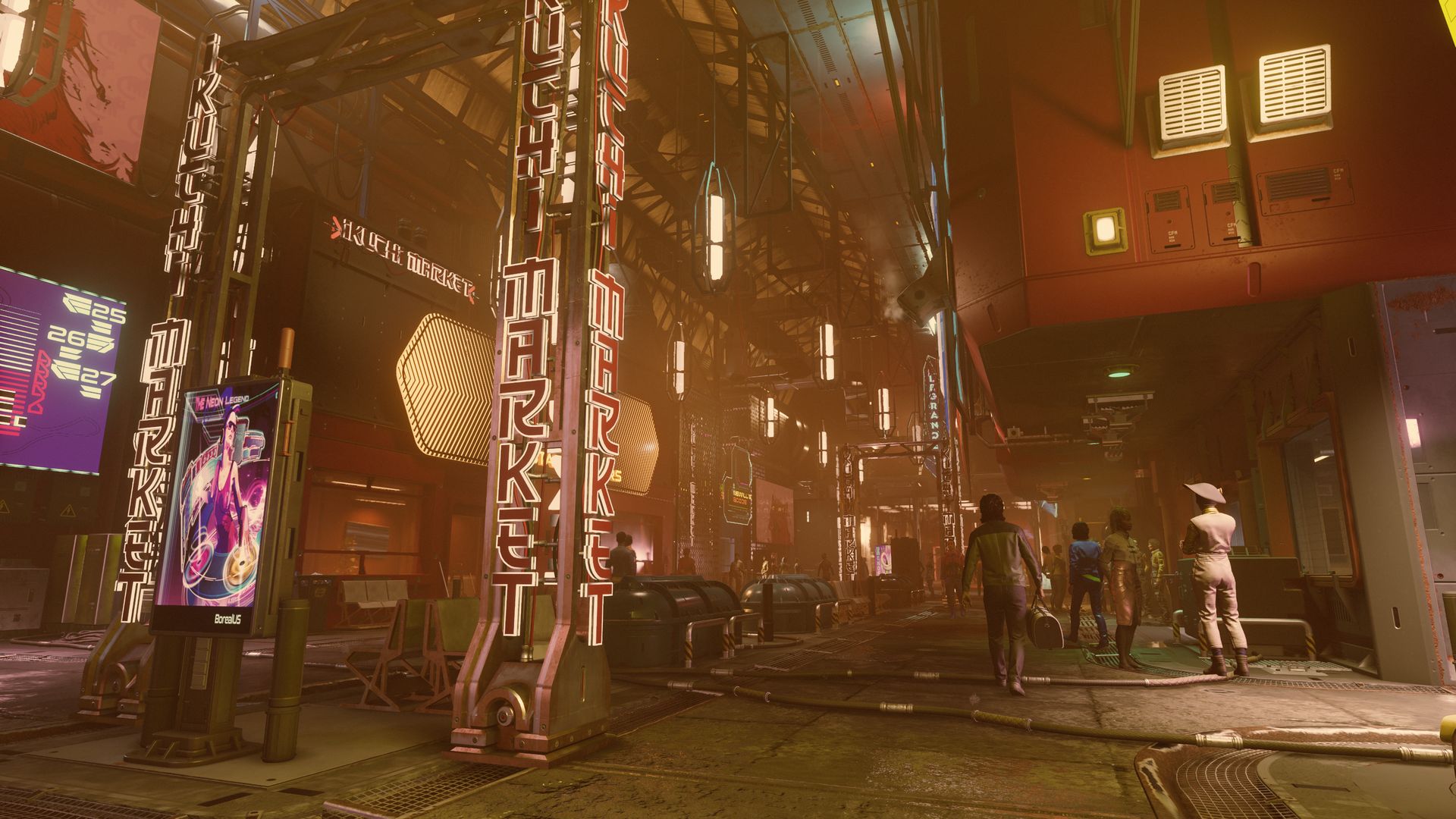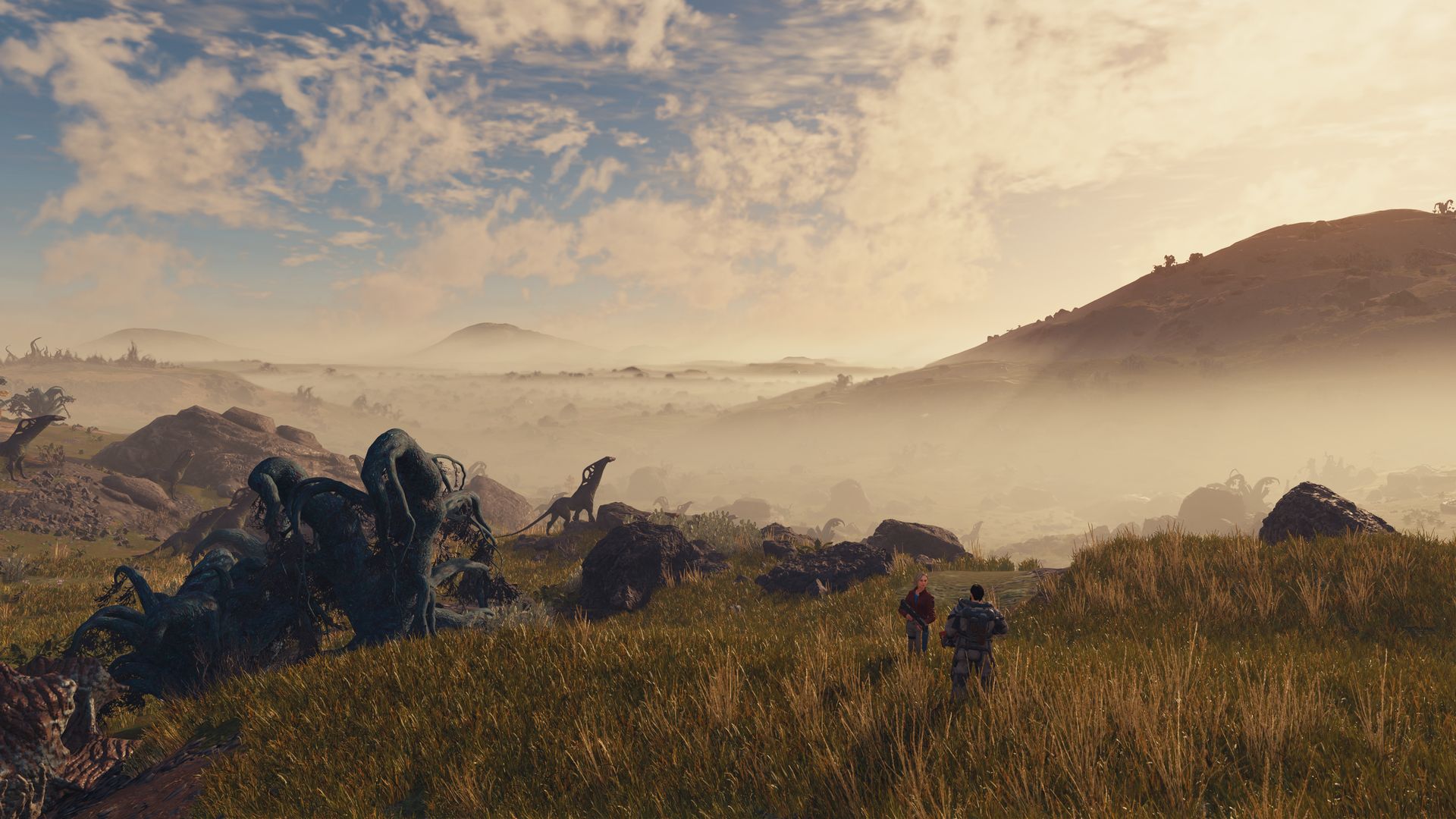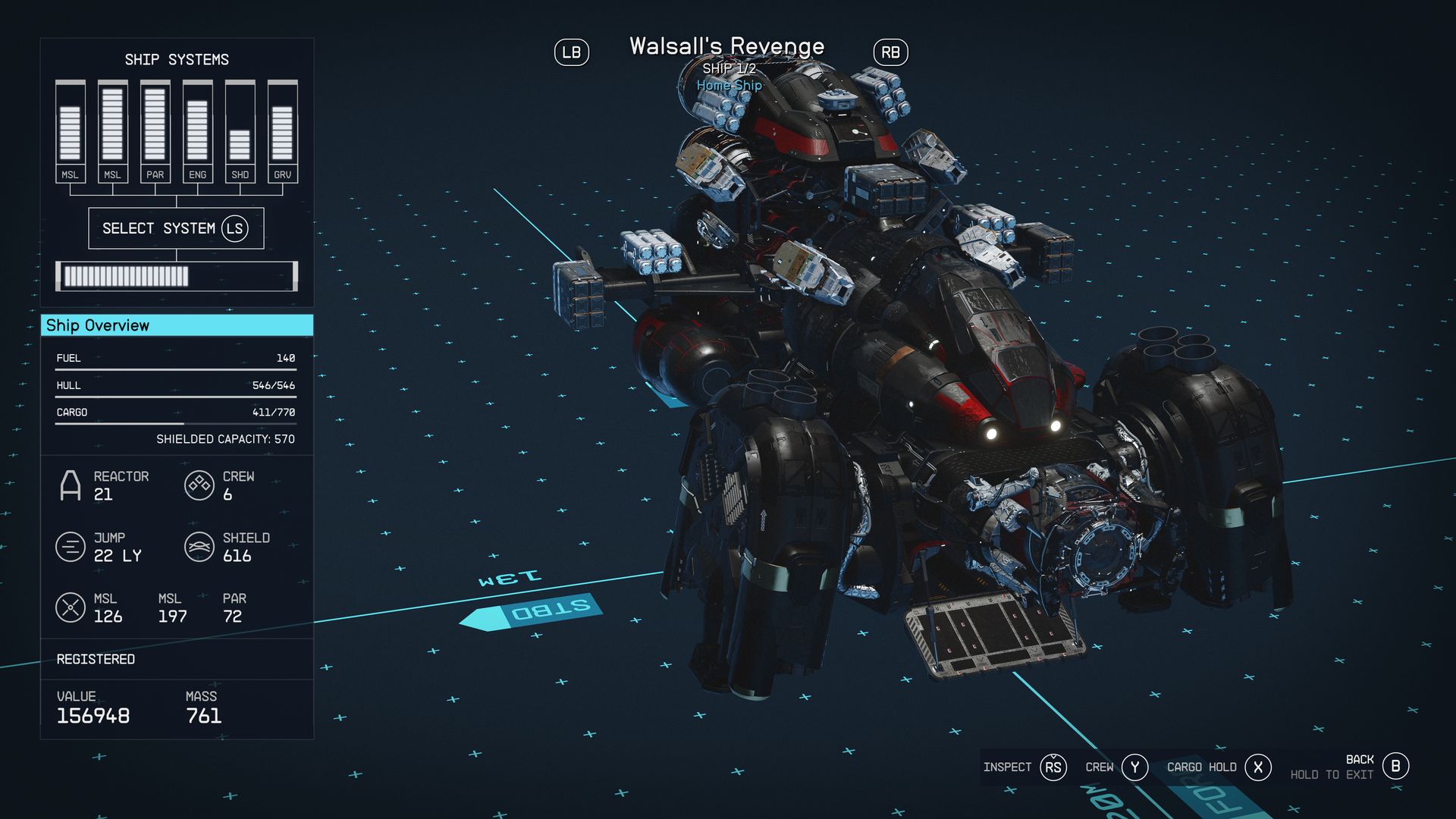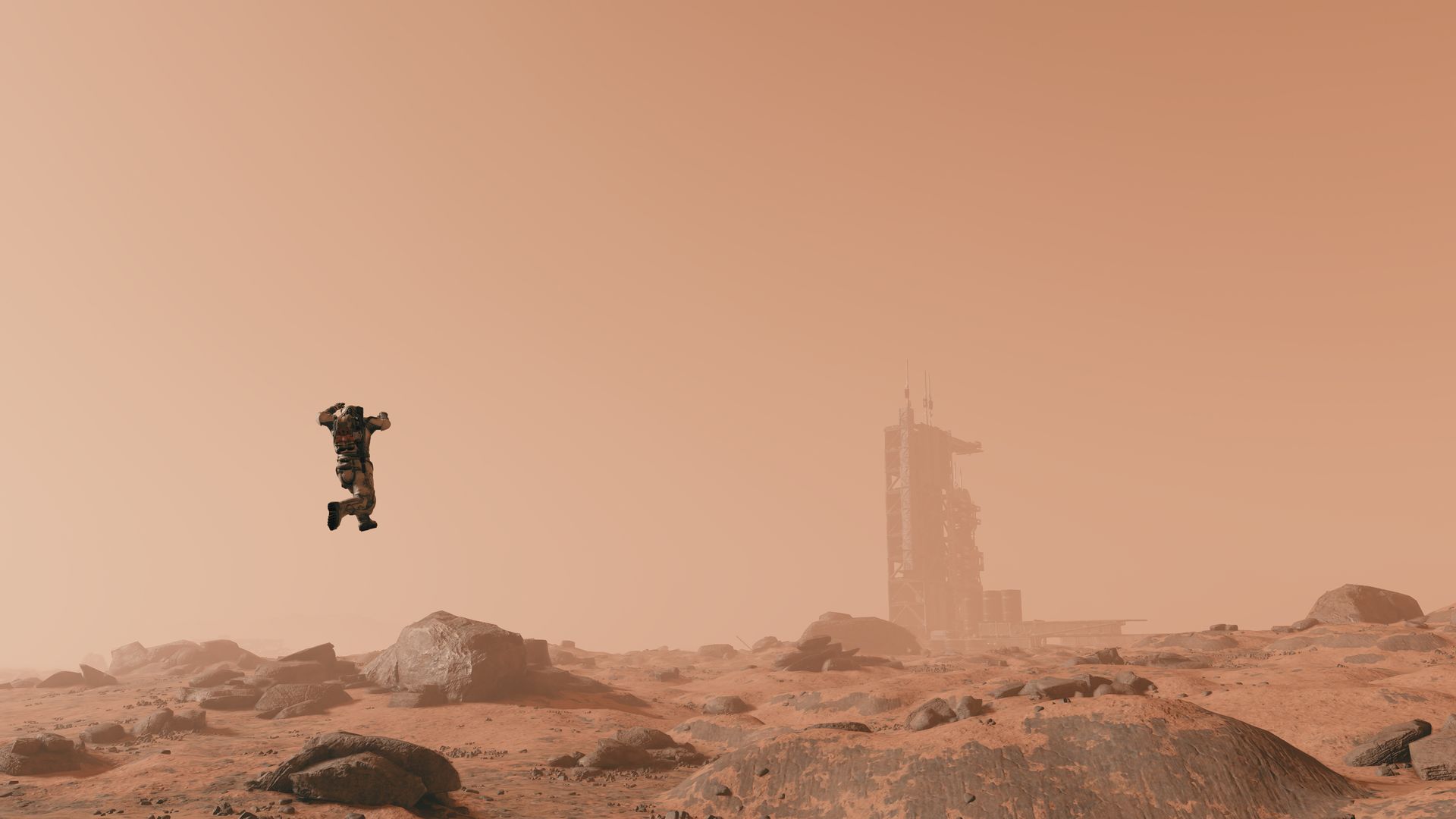Windows Central Verdict
Reviewing Starfield was a mission. It's unnecessary to emphasize how big it is. Bethesda's new IP spans a large quadrant of our Milky Way galaxy, with hundreds of star systems and planets loaded with potential gameplay. Starfield pushes its Creation Engine to the absolute limit, and cracks of age are indeed beginning to show. While aspects of Starfield's design could've used more iteration, it's one of Bethesda's most impressive cinematic titles. With incredible writing, its slow-burn stories snowball into immense moments, and tight RPG/FPS combat thrills in spaceship battles, grounded firefights, and zero-G death ballets — Starfield is a landmark experience with a bright future ahead of it.
Pros
- +
An incredibly rich and fresh take on sci-fi realism
- +
Deep lore and consistent backstories make a lifelike universe
- +
High-quality, hand-crafted story content for quests
- +
Some of Bethesda's best environmental design work
- +
Improved gunplay with spectacular ship combat
- +
Creation Engine nails zero-G combat, seamless construction systems, and environmental effects
- +
The single most polished game launch in Bethesda's history
Cons
- -
Introductory hours overwhelm with reams of systems, quests, and concepts delivered too quickly
- -
Uncanny NPCs are too ugly and stiff in 2023, with close-up shots detracting from great voice acting
- -
UI is too minimalistic for its own good, considering the complex systems within
Why you can trust Windows Central
Our Starfield review is here. This has been one of my most grueling review cycles in recent memory. While Bethesda gave us a generous amount of time with the game, it fell in the middle of previously-planned Gamescom 2023 travel. My body also decided to contract some kind of space virus, with a fever triggering auditory hallucinations. In reality, my girlfriend was sadly not offering me a sandwich.
Fighting through this delirium, I present our full review of Starfield, penned by myself and my good buddy, co-author Samuel Tolbert. But why are we using two writers for this review? Aside from the fact I feel like I'm being sucked into the vacuum of space through a tiny viewport — Starfield is so damn huge, so utterly vast, that every single player will likely have a wildly different experience with this landmark title.
Samuel focused heavily on the game's main story quest, playing as a goodie-two-shoes (sorry, Samuel.) I beelined into the much-advertised piracy with Crimson Fleet, indulging in exploration gameplay and ship-to-ship combat. Some of my colleagues joined up with the space cowboys of Freestar Rangers, while others got sucked into the economic benefits of Starfield outpost building and manufacturing. There's so much on offer here, but we're here to answer the question: Is it for you?
Everyone on our team has spent over a hundred hours on the game and had wildly different experiences. Finalizing my opinion of Starfield has been somewhat of a rollercoaster, with heady highs pushing me towards a fabled 5 stars and irritating lows making me consider 4, so we've collectively settled on 4.5/5. Some flaws frustrate proceedings, but experiencing climactic moments that Bethesda is well-known for, and rocketing to all-new heights represent experiences that will stick with me — and I feel like that's getting rarer as I get older and evermore cynical.
However, getting to Starfield's biggest payoffs can be a slow burn, which may be off-putting for many from the outset. Those who stick with the experience may discover it as their next favorite game.
Committing these concepts to writing without delivering spoilers will be tough, but don't expect any in this review. I feel that scores for this game could be all over the place based on how players build their experiences. However, I'm confident that for most people, Bethesda die-hards, in particular, will be rewarded for their faith. Starfield is a thought-provoking, daunting, and landmark experience for Bethesda Softworks, with a bright future ahead.
Disclaimer: This review was conducted using codes provided by Bethesda Softworks, primarily on Xbox Series X, with some testing on Windows PC.
All the latest news, reviews, and guides for Windows and Xbox diehards.
Starfield: Graphics, sound, and performance
Platforms: Xbox, Windows PC
Developer: Bethesda Softworks
Launch date: September 1 (early access,) September 6 (global)
Xbox Game Pass: Yes
Xbox Play Anywhere: Yes
Players: Single-player
Time to complete: Main story: 20-30 hours. Other stories: 100-200 hours. Everything: 10,000+ hours (probably)
Price: $59.99
Let's kick it off with some audio and visuals, shall we? Given Bethesda's notoriety for glitches, I figured it was probably a good place to start. Some of the discourse has revolved around Starfield's potential to come in hot, particularly as so many AAA games seem to launch in a sub-optimized state.
I'm pleased to report that Starfield is Bethesda's most immaculate game launch to date. Hundreds of hours among the team, and the few bugs we did experience were already fixed during patches during the review period. Given its scope, the game is polished to a mirror sheen, which is a genuinely Herculean achievement.
That being said, the engine is undoubtedly showing its age. Even during the Fallout 4 review cycle back in the day, one of the central criticisms of the game was how dated it looked, and Starfield presents something of a mixed bag on that front.
When Starfield's visuals deliver, oh boy, they really deliver. Global illumination cleverly washes the game in evocative tones that bring alien valleys to life in a way that previous iterations made in the Creation Engine simply could not. Absurd draw distances can make a straightforward mountain climb incredibly rewarding and meditative, flanked by the majestic and hopeful soundtrack by Inon Zur.
Starfield also delivers with its art direction, which is unlike anything the studio has previously attempted, in a sense. While The Elder Scrolls is steeped in fantasy and Fallout is washed in post-apocalyptic, almost comedic Mad Max over-the-toppery, Starfield strikes into grounded sci-fi realism to incredible effect, taking place some 200 years into the future.
Gravity drives have enabled humanity to chase the stars and escape Earth with a dying magnetosphere. Still, in the post-war environment Starfield takes place in, technological advancement has played second fiddle to local conflicts, Cold War paranoia, and rampant piracy. The art direction is restlessly consistent with the game's lore and world-building as a result, with every item telling a story of humanity's wistful nostalgia for Earthen society.
There are sterile, near-medical-looking electromagnetic guns that scream sci-fi, sitting next to more traditional-looking rifles complete with wooden stocks, evolved from the Terran weapons of old. Even antique Earth weaponry has made its way into the stars as well, modifiable with in-era tech that emphasizes Starfield's 'NASApunk' design goals. Someone at Bethesda was very passionate about food item design, too.
Examining these items in the inspection viewer reveals a team unified in pursuing a persistent universe, with industry-leading world-building and best-in-class lore design. It extends out to the game's cities and settlements, ranging from the utopic climbs of New Atlantis to the neon-washed port of, well, Neon, one of my favorite cities I've ever seen from Bethesda. Its density hides something interesting around every rusted corner.
Seedy bars, corrupt politicians, and desperate underclasses carve out a dire existence. It's within these hand-crafted locales where Bethesda's art style and environmental visuals really shine. But like I said in my introduction, the high highs come with some low lows.
Great lighting, effects, sound, and city design cannot sadly hide where Creation Engine seems to falter most, and that's in practically anything 'organic.' While the art direction of the aliens is truly awesome (and varied, there are a LOT of aliens in this game,) they all too often have this plasticine finish that almost looks out of place in some of the screenshots I've taken. However, they're aliens — maybe they're supposed to look that way, right?
Sadly, the same stiffness extends to the game's NPCs, which are wooden and rigid in their digital performances. I'm not sure it's viable to have asked Bethesda to perform full mo-cap on thousands of NPC interactions. Still, it's undeniable that the zoomed-in view from games like Oblivion, Skyrim, and Fallout 3 does not work in Starfield. Up close and personal, the ugly NPCs had me staring into the subtitles instead, rather than watching their glassy eyes hook to random objects out of shot.
I didn't care about ugly NPCs when I was a teen exploring Oblivion. I didn't mind Xbox's 30 FPS while putting hundreds of hours into Skyrim and Fallout 4, either.
Indeed, perhaps due to bugs that may be fixed, NPCs and even the player character have these tendencies to look where they're not supposed to, giving the impression that they may be enduring an unfortunate seizure. I'm not quite sure what it would take to rectify some of these uncanny performances in Bethesda's aging engine, but to deny that it detracts from the game's otherwise great storytelling (more on that shortly) would be a lie.
Still, I adjusted to it over time. I didn't care when I was a teen exploring Oblivion. I didn't mind Xbox's 30 FPS while putting hundreds of hours into Skyrim and Fallout 4. Your mileage may vary, of course. But for me, Starfield's sheer abundance of raw, hand-crafted content on offer ultimately didn't detract from the game's most significant payloads: story and gameplay.
Starfield: Gameplay
Starfield's gameplay is a wild mishmash of different concepts, features from other games, and raw, untamed ambition that showcases the Creation Engine at its most versatile. Bethesda is one of the few modern 'AAA' developers that still work restlessly to endorse and empower modders and creators with its flexible engine. To that end, Starfield should prove a suitable platform for fresh content for years to come.
What if you're not interested in that aspect of the game, though? In that instance, some of the trade-offs may not be worth it. Starfield is a first-person shooter at heart, and it's clear that Bethesda wanted to vastly revamp and refine its moment-to-moment combat experience coming out of Fallout 4. The devs iterated heavily on Fallout 3, and naturally, Starfield exhibits the same here, with great-feeling, tactile, and versatile weaponry that punctures, irradiates, and incapacitates enemies in all sorts of glorious ways.
However, unlike Fallout, Starfield has absolutely no gore or dismemberment, with violence minimized to occasional blood textures. Not every game needs to be a splatter-fest, of course, but at the outset, Starfield's gunplay did feel like something was missing. However, it's not long into the main story quest you get some other particular 'abilities,' which we won't spoil in depth here. If you saw the tease near the end of the Starfield Direct from back in June, you'll have an idea of what I'm talking about.
As such, Bethesda trades the wanton bloodlust of Fallout for physics-heavy combat experiences in Starfield, and it does so to tremendous effect.
One of the most powerful experiences I had with Starfield's combat was in zero-G. I discovered a ship with a distress signal out in space and subsequently docked with the damaged vessel to see what was going on. Inside, it had been taken over by nameless raiders, but there was a quirk. The ship's artificial gravity mechanisms had become intermittent. Every thirty seconds, gravity cycled on, then back off again, sending objects careening around with chaotic abandon.
Enemies react surprisingly well to Starfield's vertical combat design, using jet packs and cover in 3D planes seamlessly as the situation calls for it. Your weapon's bullet velocity and power also affect how you float through space and how hard enemies will crash around when they've soaked some space slugs. This was one of my earliest 'holy shit' moments with Starfield's combat design, although it took a fair while to get there.
Enemies react surprisingly well to Starfield's vertical combat design, seamlessly using jet packs and taking cover in 3D planes.
One of Starfield's biggest problems pertains to its early pacing, I would say. The intro to the game is not great and is arguably the weakest I've seen from the studio. I felt utterly overwhelmed with choice paralysis as systems like outpost building, ship construction, piloting, and companion mechanics, alongside an avalanche of quests and other tutorials, pounced on me within the first 10 minutes of the game.
Long-time Bethesda fans may relish Starfield's openness, but I think newcomers will suffer cognitive overload.
It reminded me of my first attempt to play Oblivion — I didn't get it. "Wait, I can do anything?" I had to remind myself that I don't have to do everything that Starfield offers, but I wonder how many players will power through some of the structural complexities of this game. I did, and I'm oh-so-grateful for it.
We'll get into the story quests in the next section (spoiler-free, of course), but Starfield's gameplay shines most when it revolves around its hand-crafted moments. Without spoiling the events, I would argue that some set pieces represent Bethesda's best-ever work. I sorely hope you stick with the game long enough to reach them.
Indeed, actually reaching some of those moments can be a slog if you can't tolerate some of the game's foibles. The game has a vast abundance of load screens, owing to the vastness of its world. Once you've visited a planet once, you can fast travel to it — but if you have contraband or a bounty on your ship, you will get halted in space and have to deal with the space police. It wasn't clear why I'd made the NPCs so mad for the longest time, alongside the vague rules for when fast travel works and when it doesn't.
Encumbrance can also hinder fast travel, of course. Carrying too much space junk prevents you from immediately traveling halfway across the galaxy. The Creation Engine feels a bit wrought with its intermediary space travel system bolted on top of its core features. Much like Todd's infamous quote about Fallout 4 base building, however, "It just works." You can custom-build a spaceship down to its interior and look out the windows as your ship's grav-drive whirs into life and sends you across the galaxy. Providing you have enough fuel, that is.
You can engage with these systems to fine-tune your ships and outposts, too, or ignore them completely. The game gives you a decent ship from the outset, which can be easily upgraded to accommodate any space travel you need for the story. Personally, I absolutely love Starfield's ship combat. It borrows from traditions set out in Elite and perhaps No Man's Sky, with the seamless Creation Engine build-a-ship systems on top of it.
Enemy ships fall apart into their constituent pieces in a glorious fireball when you emerge victorious. Bethesda also makes incredible use of ship combat for some of its major story moments, which, again, I shall not spoil. There have been days where I lost hours of potential review time just flying around, acting like an asshole pirate to innocent trading ships.
As fun as the gunplay can be, and ship combat events certainly are, not every aspect of Starfield's gameplay delivers. I would say some of Starfield's weakest gameplay aspects pertain to exploration. Especially planetary exploration. I'll rarely land on a planet and find something interesting. I don't expect to find anything cool on a barren moon, but even the temperate planets are often a bit arid. I've put a significant amount of time into exploring some of the game's 'radiant' procedurally-generated worlds, and while the technology powering them is impressive, I think even the most die-hard space-farers will find it a bit dull exploring these areas.
Starfield's planetary exploration is on the edge of being interesting, though, and I reckon subsequent updates will improve this aspect of the game. The survival-style 'conditions' you can endure, such as toxic fumes, alien diseases, or sprained body parts, can mostly be ignored since they barely affect gameplay, even on 'Very Hard' difficulty. Exploration traversal is also a bit of a chore. These days, I try to avoid armchair development or feature-creeping in reviews and just examine what's on offer, but the fact that Starfield doesn't have any sort of planetary vehicle play is a glaring omission.
If you're playing as a pirate, it's always fun to rob unfortunate traders jumping between systems.
Running or jet-packing across a planet's surface is, again, a chore, and why we couldn't have had some kind of personal mech horse (which exists in the game as Boston Dynamics-esque horrors) to ride or a hovercraft to traverse to those points of interest, feels like missed low-hanging fruit. You could've even sold mech horse armor, Bethesda! (Don't give them ideas.) Why can't I ride on Vasco's back or something?
Still, the exploration gameplay is completely superfluous and only really necessary if you enjoy the meditative, Minecraft-style experience of exploring what could be there. To be fair, occasionally, the radiant quests do deliver. The zero-G combat experience I mentioned above was one such instance. At one point, I also came across another derelict ship in space filled with something incredibly creepy, which I won't spoil, but will also stick with me. I found a derelict space station casino full of credits to pilfer. If you're playing as a pirate, it's always fun to rob unfortunate traders jumping between systems, too.
Where Starfield really burns brightest is in its story gameplay. I've enjoyed Hitman-esque stealth missions as an aforementioned Crimson pirate. I've explored mysterious alien structures as part of the explorer's organization Constellation. I've become a deputy for the space rangers. I've traversed decaying battlegrounds of irradiated mech skeletons and roaming xenowarfare bioweapons.
I truly feel like I've barely scratched the surface of what Starfield has to offer, despite my faster-than-light effort to get through as much of the game as possible to hit this embargo.
While spectacular events, awesome guns, and great hand-crafted moments pave over the flaws, I would've liked to have seen Bethesda iterate more on some of these long-standing Creation Engine foibles. However, once you get past it, the story delivers so incredibly well that you most likely won't care about its issues.
Starfield: Story (no spoilers)
Starfield is set in the year 2330, in a cluster of the galaxy called the Settled Systems. As a budding space miner, you have a strange encounter with a mysterious artifact buried deep within an excavation that changes the course of your life. It's not long after that Barret from Constellation arrives on the scene. Constellation is an organization of spacefarers searching for the answers to life's mysteries, including such heady concepts as "Why is humanity even here?"
As we mentioned, things are slow-going in the game's first couple of hours, with little information as to what is going on or why you should even need to care. The temptation to wander and let the galaxy distract you is always burning, but it's at its strongest right from the outset. Slowly, steadily, that changes.
At multiple points, when faced with uncertainty, you're not just asked but encouraged to debate about just what it is you're searching for. This feeds back into the exploration of the galaxy and the questions these unknown artifacts represent. Unfortunately, humanity has exported some of its ugliest habits to the stars, with the distribution of wealth remaining a key theme throughout. Like any Bethesda RPG, you can chart your position when faced with some of these questions.
Starfield asks you to recognize that there is wonder in the galaxy and to perhaps question why you're here to see it and if that even matters. Religion and God are recurring themes, too, alongside the motivation for simply being. The vastness of Starfield's gameplay canvas is as much a literary tool as it is a sandbox device, as the game's factions splinter into power struggles despite the potentially deeper questions and implications lurking in the background.
Constellation also forms the basis of your inner circle, with a cadre of companions who each have their reasons for joining. Spending time with them grants the possibility of friendship, new stories, dark mysteries, and even romance. You're not technically required to deepen your companionship outside a select handful of missions. Still, I wanted to learn the tales of what makes everybody tick, from space cowboy Sam Coe's familial ties to the mysterious Andreja and her past.
The relationships you foster with your companions matter a great deal in the main storyline, more than they ever have in past Bethesda titles. There are some surprising moments in store depending on who you spend your time with, to the point that I expect there'll be a lot of "Wait, so what happened for you?" conversations between friend groups. It's not a requirement, but like so much of the game, the more you lean into what Starfield offers, the more it leans forward to reward you.
Bethesda is no stranger to impactful moments. The Oblivion Crisis. Stepping out of the Vault in search of your dad in Fallout 3. Skyrim's story of the world-devouring Alduin and the trek to stop him. Key moments stick out, but I would argue they were often not the main reason players journeyed across Tamriel and post-apocalyptic America. That hasn't been the case in Starfield. There's almost a meme amongst long-time Bethesda players that the main story quest should be an afterthought. Starfield absolutely bucks that trend, baked with intrigue, memorable characters, and big setpiece moments that will forge lasting memories for those who seek them.
Even removed from how you affect your companions and how they affect you, Starfield's main path provides plenty of twists and turns that had me on a hook. Things do unfold slowly at first, but when they start rolling, snowballs of ideas become an avalanche of wonderment. The story somehow manages to embrace a love of classic science fiction while eschewing the more obvious tropes, and I found myself writing down theories in my notes to try and weigh the odds of just what was going on. More than anything, that's the uniqueness of this adventure. It's not just the journey but what it asks you to consider.
It's an oversimplification to say players have simply found their own fun in the past, but for many, even myself at many points, the story in a Bethesda game wasn't what the main quest journal entries said — it was what you found out in the world. But Starfield is the most impactful story Bethesda Game Studios has ever told by a considerable margin. Yet it does so without neglecting that side content that players know and love. From the mundane and absurd to the horrific and unsettling, there's a lot to explore, with weaving multi-hour adventures that never feel generic.
Some faction questlines here could've been the focus of their own expansions. I devoted several hours to a particular storyline that dealt with the struggles of the United Colonies SysDef Navy and the Crimson Fleet pirates. This quest chain, in particular, represents a return to form for Bethesda's branching narrative capabilities, offering the player a lot of leeway in choosing what ultimately happens at the incredible climax of this world-changing story.
The culmination of this questline, after hours of watching plots unfold and having a hand in who lived or died, the simple act of watching a plot device I had shaped slowly power up carried more emotional weight for me than any typical 'cinematic' cutscene might have. Simply jaw-dropping. Many of these primary faction' side quests' will probably become Bethesda classics, alongside the likes of The Elder Scrolls' Dark Brotherhood or Fallout's Brotherhood of Steel.
Starfield is the most impactful story Bethesda Game Studios has ever told, by a considerable margin.
Indeed, in general, Starfield is also a return to form in being a true role-playing game, bringing back elements that were somewhat watered down in more recent Bethesda titles. The choices you make matter, and they're informed by what skills you have. If you're not able to persuade someone to give you blackmail material, then you may have to find a different, potentially less-savory way of getting what you want.
There are a fair few characters with 'plot armor' invincibility, some I would argue unnecessarily so. But it's a hard swing back in the right direction, following Fallout 4's fairly retracted approach to branching writing.
Starfield has a grand scope with 1,000 worlds to explore, with epic space battles, uneasy mysteries, laughable moments, high-stakes double-agent espionage, and murky underbelly dealings. But despite all of it, Starfield is a surprisingly personal story that wants you to ask questions. About yourself, our purpose, the universe, and how far you'd go in pursuit of the answers.
It's difficult to impress the grand scale of Starfield's moments without going into spoiler territory. You'll have to trust us and power through.
Starfield: Conclusion
Starfield tries to do a lot. Over the course of writing this review, I've gone from a 4/5 to a 5/5 and eventually settled on a 4.5/5. The highs are extremely high, but the lows are baked into the system and trip up what would otherwise be a perfect sci-fi gameplay experience.
Getting the bad stuff out of the way first, Starfield's planetary exploration gameplay is flawed in a number of ways. The game has quality-of-life problems that have been an issue with Bethesda titles for over a decade, and the procedurally generated 'radiant' planets will not be everybody's cup of space tea.
The uncanny, mannequin-like NPCs degrade otherwise excellent voice acting and story delivery. Omissions like planetary vehicles are also glaring in the context of the game. And it's getting tougher to forgive Bethesda for things like inventory management, given that they've been an issue in Oblivion, Skyrim, Fallout 3 and 4, and even Fallout 76.
Some of these issues result from engine-level trade-offs, as one of the few game engines designed with modders in mind. But it's too much to ignore for players who aren't interested in that aspect of the Starfield package. However, when Starfield delivers, it truly delivers in a big and bombastic way that only Bethesda Softworks can.
You should play Starfield if ...
- You're a fan of that hard, dry Bethesda formula circa Oblivion.
- You love heady sci-fi concepts and stories akin to Nolan's Interstellar or Tarkovsky's Solaris.
- You want to be a murderous space pirate, a charming space cowboy, or a rich AF space trucker.
- You're expecting a Bethesda game through and through and not something beyond that.
- You have Xbox / PC Game Pass!
You should skip Starfield if ...
- You're easily irritated by dated-looking NPCs.
- You don't have dozens, maybe hundreds of hours to spare, even if the payoff is worth it.
- You've never really liked Bethesda's RPG formula.
Starfield more than makes up for its shortcomings with its absolutely monstrous amount of hand-crafted content. I've sunk well over a hundred hours already into this gargantuan effort, rich with deep and intriguing in-universe history, memorable characters, and stunning environmental design. Some of the major hand-crafted quest chains take a while to get going, but the unashamed slow-burn approach ultimately pays off — Starfield sports some of the most epic, most climactic moments I've experienced in gaming.
It's hard to impress just how much I've been floored by some of Starfield's major moments, and I think a lot of reviews will hinge on just how far and how deep content creators got into the game's bread and butter: that main story and those ambitious faction quests. Many of the game's primary hand-crafted quest chains are so large and ambitious that they could've been full games in their own rights.
If Starfield 'clicks' for you, you may find yourself obsessing over this game for many years to come — I know I will be. I grabbed the Collector's Edition right after finishing the Crimson Fleet quest chain because I found myself just falling in love with the world. I'm also starting over from scratch as soon as this review is done to correct some of my less-optimal build-designing choices and revamp some decisions I made while rushing to get to the game's big moments. Starfield is a wonder, and I'm eager to go and play it for fun rather than for work very shortly.
It's true that Starfield is definitely flawed in some ways, but overall, Starfield is a staggering achievement and has an incredibly bright future ahead of it, regardless of anything said here or anywhere else.
See you, space cowboy.

Bethesda rewards the faithful with one of Microsoft's best exclusive games in over a decade. With great storytelling and an exciting new world, Starfield is a triumph.

Jez Corden is the Executive Editor at Windows Central, focusing primarily on all things Xbox and gaming. Jez is known for breaking exclusive news and analysis as relates to the Microsoft ecosystem while being powered by tea. Follow on Twitter (X) and tune in to the XB2 Podcast, all about, you guessed it, Xbox!
- Samuel TolbertFreelance Writer














